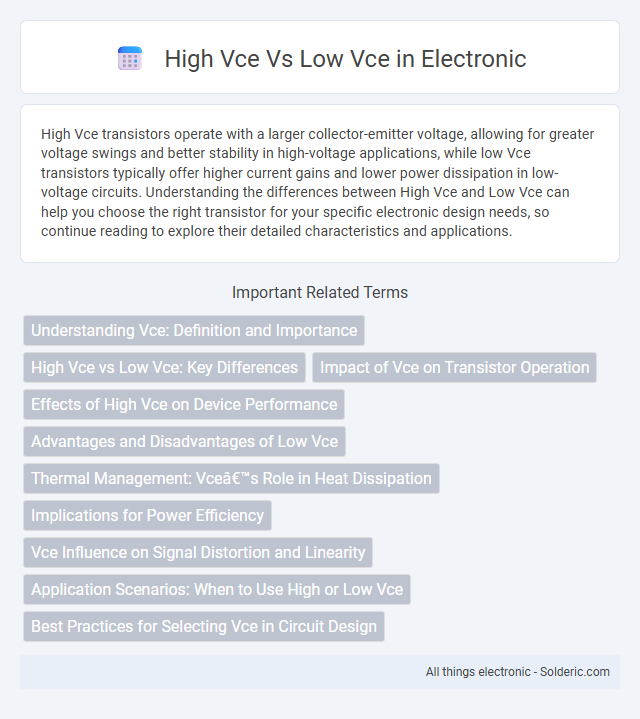High Vce transistors operate with a larger collector-emitter voltage, allowing for greater voltage swings and better stability in high-voltage applications, while low Vce transistors typically offer higher current gains and lower power dissipation in low-voltage circuits. Understanding the differences between High Vce and Low Vce can help you choose the right transistor for your specific electronic design needs, so continue reading to explore their detailed characteristics and applications.
Comparison Table
| Parameter | High Vce | Low Vce |
|---|---|---|
| Definition | Higher Collector-Emitter Voltage rating | Lower Collector-Emitter Voltage rating |
| Applications | High-voltage circuits, power switching | Low-voltage applications, signal amplification |
| Maximum Voltage | Typically above 100V | Typically below 100V |
| Power Dissipation | Higher power handling capability | Lower power capacity |
| Switching Speed | Generally slower due to higher voltage rating | Typically faster switching speeds |
| Cost | Usually more expensive | More cost-effective |
Understanding Vce: Definition and Importance
Vce, or Collector-Emitter Voltage, is a critical parameter in transistors that measures the voltage difference between the collector and emitter terminals. High Vce indicates the transistor is in the active or saturation region, allowing maximum current flow, while Low Vce signifies minimal voltage drop and efficient conduction. Understanding Vce is essential for optimizing transistor performance, ensuring reliable switching, and preventing damage due to excessive voltage.
High Vce vs Low Vce: Key Differences
High Vce transistors operate with a higher collector-emitter voltage rating, allowing them to handle larger voltages but typically at lower currents and gain, making them suitable for high-voltage applications such as power supplies and RF circuits. Low Vce transistors have lower voltage ratings but offer higher current capacity and gain, optimizing performance for low-voltage, high-current environments like switching and amplification in consumer electronics. Understanding the Vce rating impact on transistor switching speed, power dissipation, and thermal stability is crucial for selecting the right device for specific electronic circuit requirements.
Impact of Vce on Transistor Operation
High Vce increases the collector-to-emitter voltage, allowing the transistor to operate in the active or saturation region with greater voltage headroom, improving gain and switching speed. Low Vce limits the voltage across the transistor, often shifting it toward the cutoff or saturation region, which may reduce current flow and cause distortion in analog circuits. Proper Vce selection ensures optimal transistor operation by balancing voltage, current, and power dissipation requirements.
Effects of High Vce on Device Performance
High Vce in a transistor leads to increased power dissipation and higher junction temperature, which can degrade overall device reliability and lifespan. Elevated Vce also causes higher electric fields within the device, potentially resulting in breakdown or reduced gain efficiency. Managing high Vce is crucial for maintaining optimal switching speed and minimizing thermal stress in power electronics applications.
Advantages and Disadvantages of Low Vce
Low Vce transistors offer the advantage of reduced power loss and lower heat generation, improving energy efficiency in electronic circuits. However, their disadvantages include a limited voltage handling capacity, making them less suitable for high-voltage applications. Understanding these trade-offs helps you select the appropriate transistor for your specific electronic design needs.
Thermal Management: Vce’s Role in Heat Dissipation
High Vce in transistors typically results in greater power dissipation, leading to increased heat generation that demands efficient thermal management solutions such as heat sinks or cooling systems. Low Vce reduces the voltage drop across the transistor, minimizing heat buildup and enhancing overall thermal efficiency, which improves device reliability and longevity. Optimizing your circuit design to maintain a low Vce during operation helps ensure better heat dissipation and prevents thermal stress on components.
Implications for Power Efficiency
High Vce in transistors results in greater voltage drop across the device, leading to increased power dissipation and reduced power efficiency in electronic circuits. Low Vce minimizes the voltage drop, decreasing power loss and improving overall energy efficiency, which is crucial in designs aiming for low thermal output and extended battery life. Optimizing Vce levels is essential for enhancing power efficiency in applications like power amplifiers and switching regulators.
Vce Influence on Signal Distortion and Linearity
High Vce in transistors typically improves linearity by providing a larger voltage swing and reducing distortion in analog signal amplification. Low Vce operation often increases signal distortion due to smaller voltage margins, which limit the transistor's ability to maintain a linear response. Optimizing Vce levels is crucial for achieving minimal harmonic distortion and maximizing signal fidelity in RF and audio amplifier designs.
Application Scenarios: When to Use High or Low Vce
High Vce transistors are ideal for applications requiring higher voltage tolerance, such as power supplies and switching circuits handling large voltage swings. Low Vce transistors suit low-voltage, high-current applications like amplifier stages and signal processing where minimal voltage drop and power dissipation are critical. Selecting between high and low Vce depends on the circuit's voltage demands, power efficiency, and thermal management requirements.
Best Practices for Selecting Vce in Circuit Design
Selecting the appropriate Vce (collector-emitter voltage) in circuit design depends on your application's voltage requirements and power dissipation limits. High Vce transistors handle greater voltage, suitable for high-power or switching applications, while low Vce types offer faster switching speeds and lower saturation voltage, improving efficiency in low-voltage, high-frequency circuits. Balancing these parameters ensures optimal performance and reliability in your circuit design.
High Vce vs Low Vce Infographic

 solderic.com
solderic.com